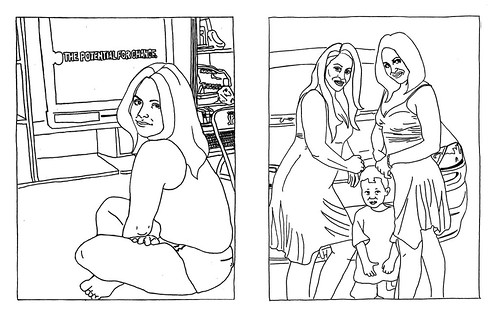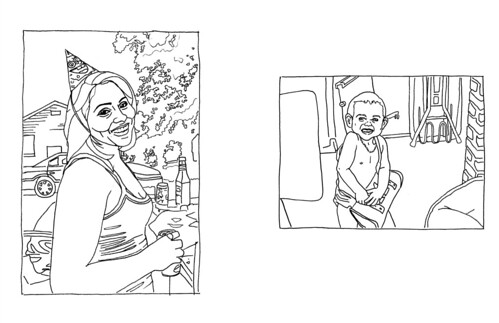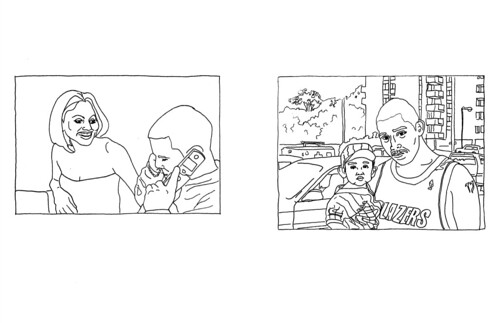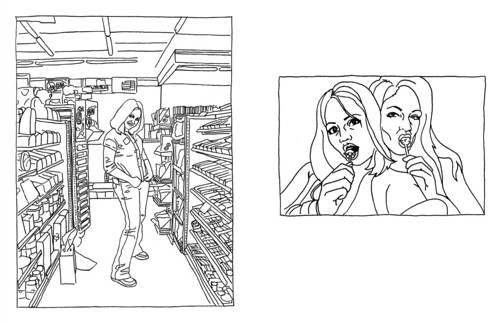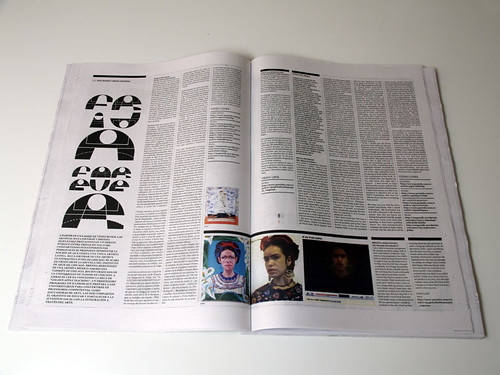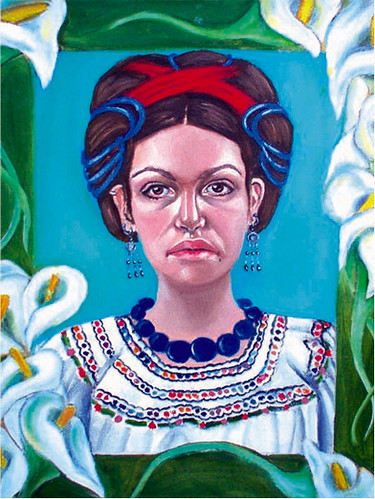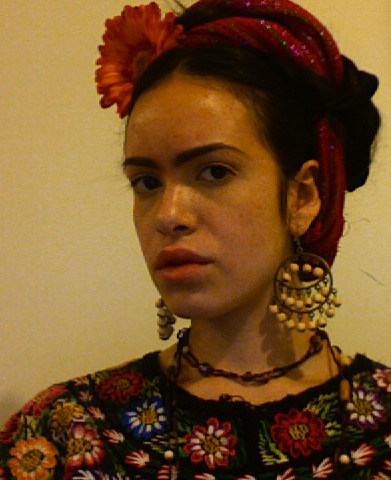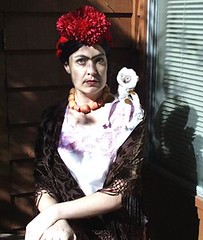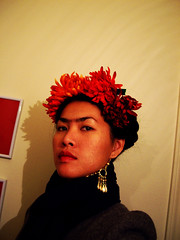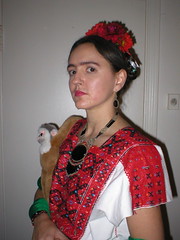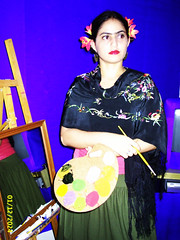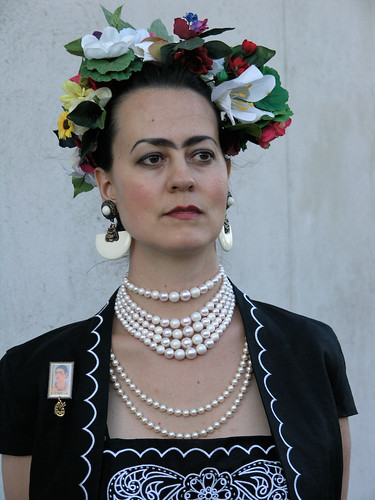I just returned from the residency I did for the Jewish Multiracial Network, located at Isabella Freedman Jewish Retreat Center. As part of my programming I worked with the youth staff to generate a series of questions regarding Jewish Identity. These questions then set the framework for the theater games (inspired by theater of the oppressed) and the flag books that we made over the course of the weekend.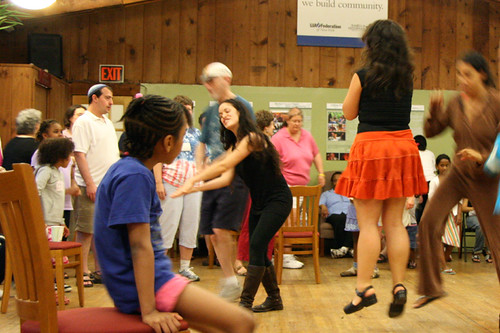 Unfortunately not everyone got around to answering these questions at the retreat, however here is a new chance :). So I now invite anyone and everyone to participate in finding answers to these questions (JMNners, non-JMNers, Jews, non-Jews..... )What do you need from society, yourself, the Jewish Community to recognize diversity and to become aware of racism, sexism, homophobia (oppression) both internalized and experienced and the times you yourself have been racist, sexist , homophobic, and then move past to create change?What do you do when you are in an uncomfortable situation regarding your Judaism?Do you have a Non-Jewish side, what is that like?What makes a person culturally Jewish?What make you a Jew in your everyday life?Define what makes someone Jewish.Name your greatest Jewish moment.Why are you Jewish?What does a Jew look like?Did you ever not feel Jewish?What is it about being Jewish that makes you most proud?What do you love about being Jewish?What was your weirdest Jewish Experience?Have you ever questioned your Jewish Identity?Has anyone else ever questioned your Jewish Identity?Have you ever questioned another persons Jewish Identity?What symbols represent Judaism for you?What non-Jewish activities do you partake in that to you are “Very Jewish”?What is your responsibility as a Jew of color?What is your responsibility as a Jew?
Unfortunately not everyone got around to answering these questions at the retreat, however here is a new chance :). So I now invite anyone and everyone to participate in finding answers to these questions (JMNners, non-JMNers, Jews, non-Jews..... )What do you need from society, yourself, the Jewish Community to recognize diversity and to become aware of racism, sexism, homophobia (oppression) both internalized and experienced and the times you yourself have been racist, sexist , homophobic, and then move past to create change?What do you do when you are in an uncomfortable situation regarding your Judaism?Do you have a Non-Jewish side, what is that like?What makes a person culturally Jewish?What make you a Jew in your everyday life?Define what makes someone Jewish.Name your greatest Jewish moment.Why are you Jewish?What does a Jew look like?Did you ever not feel Jewish?What is it about being Jewish that makes you most proud?What do you love about being Jewish?What was your weirdest Jewish Experience?Have you ever questioned your Jewish Identity?Has anyone else ever questioned your Jewish Identity?Have you ever questioned another persons Jewish Identity?What symbols represent Judaism for you?What non-Jewish activities do you partake in that to you are “Very Jewish”?What is your responsibility as a Jew of color?What is your responsibility as a Jew?
Joanna Angel: Jews & Tattoos
[youtube=http://www.youtube.com/watch?v=f9laK9l_lq0&hl=en]
- Adult film superstar Joanna Angel pokes holes at the myth that Jewish faith won't allow you to go to heaven if you have tattoos -- and Joanna's got quite a few -- during the Wild Ass Circus' trip to Las Vegas for the 2008 AVN Awards
Beverly A. Normand and the Rald Institute
Rald Institute's mission is to assist at risk children and individuals with learning, social-emotional, and other disabilities. We strive to enhance self-worth while strengthening cognitive and affective domains. We work to increase public awareness of various disabilities and function as advocates. The institute supports schools by providing technical assistance to staff. Rald provides experiences in the arts because we believe such experiences help children expand critical thinking, increase imagination and develop an appreciation for cultural diversity. Inclusive art workshops are offered at no cost to children. The institute is run by volunteers and there are no charges for services to individuals.
here is a link to an abc special on Beverly's work.
Beverly Normand, Ph.D., Founder and President, is a consultant for public and private schools in Illinois, and is lecturer and adjunct professor for several universities. She recently retired from the Office of Specialized Services, Chicago Public Schools, after thirty-four years of service as Special Education Teacher, Citywide Instructional Specialist, and Facilitator for School Based Problem Solving/Response to Intervention programs in Psychology and Special Education. She earned degrees from Roosevelt University, DePaul University and Chicago State University. She was a contributing writer for several publications of Chicago Public Schools, is the recipient of numerous educational awards, special recognitions, and various grants. She has written and hosted several educational television programs, has been published in numerous journals and magazines and has participated in various research projects.
A poet, designer, lyricist and patron of the arts, she has collaborated with artists and musicians on special projects and has planned and coordinated cultural programs and art exhibitions for school children, churches and other institutions throughout her adult life.
Serving as Commissioner of Religion and Race for the United Methodist Church in the South Shore Community of Chicago for twenty years, Normand developed activities and programs to support African American history and culture, while also planning activities and programs to strengthen multi-cultural exchange and diversity training. She served as editor for the Nimbus publication for many years.
Normand has helped thousands of pupils, parents, teachers, ancillary teams and school administrators, and is highly respected for her integrity, creativity and skills. "I believe in interdisciplinary instruction and all curricula that stimulate the imagination and lead us away from mediocrity and complacency. The mission of Rald Institute is to reduce the at-risk population, support children and individuals with special needs in a manner which leads to self-actualization, support as many parents and teachers as we can, and help twenty-first century educational leaders maintain integrity and democratic forms of leadership, while problem solving."
ARTE ≠ VIDA: ACTIONS BY ARTISTS OF THE AMERICAS
Last weekend Carianne and I went to NY for the 2008 Whitney Biennial. As we expected from a survey of Contemporary American Art, not everything in the exhibition appealed to us. However neither of us was disappointed because we were not expecting to be unilaterally wowed. Upon leaving the Whitney, we got into an in-depth discussion about individuals' preconceived expectations, and the role they play in the determining interaction/interpretation/enjoyment, with actual works of art. Soon after this conversation, I was put to the test. As any young MFA student (traveling to New York) who has any hopes of some day having a career, Carianne and I were preparing to leave our hotel, to visit the elusive Chelsea Galleries, when I came upon an announcement for a show at El Museo Del Barrio, ARTE ≠ VIDA: ACTIONS BY ARTISTS OF THE AMERICAS
“Arte no es vida” surveys, for the first time ever, the vast array of performative actions created over the last half century by Latino artists in the United States and by artists working in Puerto Rico, the Dominican Republic, Cuba, Mexico, Central and South America.
Many of the works included in Arte ≠ Vida have subtle or overt political contexts and content: military dictatorships, civil wars, disappearances, invasions, brutality, censorship, civil rights struggles, immigration issues, discrimination, and economic woes have troubled the artists’ homelands continuously over the past four decades and therefore have infiltrated their consciousness. According to curator Deborah Cullen, “the exhibition title challenges the commonplace idea that art is equivalent to life, and life is art. What is proposed through these many works is that while art affirms and celebrates life with a regenerative force, and sharpens and provokes our critical senses, artistic actions which address inequalities and conflict are not equivalent to real life endured under actual repression.”
Over 75 artists and collectives are represented in Arte ≠ Vida, including ASCO, Tania Bruguera, CADA, Lygia Clark, Papo Colo, Juan Downey, Rafael Ferrer, Guillermo Gómez-Peña, Alberto Greco, Alfredo Jaar, Tony Labat, Ana Mendieta, Marta Minujin, Raphael Montañez-Ortiz, Hélio Oiticica, Tunga and contemporary practitioners including Francis Alÿs, Coco Fusco, Regina José Galindo, Teresa Margolles and Santiago Sierra. The exhibition is arranged in four major sections, in which each decade is represented by several specific themes that often cross national boundaries. 1960-1970 looks at select precursors, signaling, destructivism and neoconcretismo; 1970-1980 considers political protest, class struggle, happenings, land/body relationships and border crossing; 1980-1990 focuses upon anti-dictatorship protest and dreamscapes; and 1990-2000 references the Quincentenary, multiculturalism, postmodernism and endurance. An additional section highlights interventions that artists have carried out on television over the past 20 years. In these chronological, thematic groupings, viewers will be able to explore the interconnections among various artists’ actions as well as the surges of activities triggered by specific events in certain countries.
I didn't know what to do. This sounded to good to be true, but we also knew we were supposed to visit the Chelsea Galleries. I considered just buying the catalogue to the exhibition and skipping the show. I don't know if it was faith or instinct that got us there, but I can say with out any doubt in my mind that this was single handedly the best exhibition I have ever attended.
"¿Quién puede olvidar las huellas?," Regina Galindo. 2003.
Galindo walking through the streets of downtown Guatemala City, wetting her feet in a blood-filled bucket, and leaving a path of footprints from the Constitutional Court building to the Presidential Palace, where she was welcomed by a police battalion. The Court had just validated former dictator Efraín Ríos Montt, the country’s foremost author of genocide, as a presidential candidate.
[youtube="http://uk.youtube.com/watch?v=D46p71QdCTc"]

Oscar Bony (1941-2002) hired a working-class family at twice their going wage to pose in a Buenos Aires gallery as a living work of art
[youtube=http://uk.youtube.com/watch?v=8N5xbLtokZY]
"Arte Reembolso/Art Rebate" by Elizabeth Sisco, Louis Hock and David Avalos. 1993.


[...] "The current economic recession has been debilitating for many artists regardless of the content of their work. Since this climate is characterized by a particular hostility toward controversial art, it is especially significant that Elizabeth Sisco. Louis Hock. and David Avalos have maintained a reputation for causing trouble in San Diego. Their collaborative public art projects receive scandalous reports in local and national news media and are often used as examples of the National Endowment for the Art' inadequate standards of quality. Their most current collaborative project Art Rebate (1993) refunded $10 bills to 450 undocumented workers along the San Diego, California/Mexico border. It was commissioned by the Museum of Contemporary Art, San Diego and Centro Cultural de la Raza as part of the "La Frontera/The Border" exhibition. In response to recent attention to border relations due to NAFTA and other government policies, the artists wished to refute the popular misconception that undocumented Mexican workers do not pay taxes as well as demonstrate. albeit with a small symbolic gesture, their appreciation of the undocumented as valued members of Western states, communities. Furthermore, I believe their work has significant implications for undocumented workers from other nations, residing in other regions of the United States - Caribbean workers in Florida and New York City, for example. If the communities in which the undocumented workers from these areas work and reside could also acknowledge their common contributions, in the form of taxes among other things, then perhaps we as a society could also begin to address the crimes inflicted upon these groups and apply our democratic notions of human rights to those within our national borders. [...]
"The projects are clearly controversial. That's not an accident. It's not as if someone latches onto the projects and holds them up as problematic. We intend to create something that is provocative and engenders a public discussion. It is public art, not art in the public. The work is defined by its performance in the community. The public discussion is crucial to the project. In order to begin a discussion we initiate an action - for example, a bus poster or a $10 rebate - that starts the ball rolling. We definitely aim to draw in the broadest spectrum of people, including those in power for the discussion. Obviously the media is not a neutral mechanism for communicating the events that unfold during the projects: it has an agenda that shapes its participation in the discussion. For example, much of the language used to describe Art Rebate in the press was the same inflammatory rhetoric promoted and laid out by the politicians who had given a profile of blame to the undocumented. Similarly, the press had a hard time imagining, and therefore was unable to fairly convey, the undocumented as taxpayers. The press was invited to experience the act of rebating these signed $10 bills. They were encouraged to ask the opinion of undocumented workers concerning their status as taxpayers, but the responses failed to appear prominently in the news media. The media coverage was not a means of evaluating the project but rather a component of the project. Their viewpoints describe a conceptual social space in which they situate the taxpayer and the undocumented in different realms."
"The Parthenon of Books/Homage to Democracy, Buenos Aires," Marta Minujín. 1983.
In December 1983 the Argentine Conceptual artist Marta Minujin and a group of helpers spent 17 days building a full-scale model of the Parthenon in a public park in Buenos Aires, Roberta Smith writes. Except for a metal scaffolding, it was made almost entirely of books wrapped in plastic. All the books had been banned by one of the most oppressive juntas in the country’s history, which was just being dismantled after Argentina’s first democratic election in a decade. “The Parthenon of Books/Homage to Democracy,” as Ms. Minujin’s work was titled, stood for about three weeks. Then the public was allowed to disassemble the piece and keep the books.
partenon de libros marta minujinAvenida 9 deJulio y Avenida Santa Fe. Buenos Aires. Argentina. Concebida como un monumento a la democracia y a la educación por el arte, Partenón constaba una estructura metálica, réplica del partenón, recubierta con prohibidos durante la dictadura militar.


[...]In a similar fashion to the live human spectacles of the past, Fusco and Gomez-Peña performed the role of cultural "other" for their museum audiences. While on display the artists' "traditional" daily rituals ranged from sewing voodoo dolls, to lifting weights to watching television to working on laptop computers. During feeding time museum guards passed bananas to the artists and when the couple needed to use the bathroom they were escorted from their cage on leashes. For a small donation, Fusco could be persuaded to dance (to rap music) or both performers would pose for Polaroids. Signs assured the visitors that the Guatinauis "were a jovial and playful race, with a genuine affection for the debris of Western industrialized popular culture . . . Both of the Guatinauis are quite affectionate in the cage, seemingly uninhibited in their physical and sexual habits despite the presence of an audience." Two museum guards from local institutions stood by the cage and supplied the inquisitive visitor with additional (equally fictitious) information about the couple. An encyclopedic-looking map of the Gulf of Mexico, for instance, showed the supposed geographic location of their island. Using maps, guides, and the ambiguous museum jargon, Fusco and Gomez-Peña employed the common vocabulary of the museum world to stage their own display[...]
"Construction of a Traditional Rural Oven,'' Víctor Grippo y Jorge Gamarra. 1972.
CONSTRUCCION DE UN HORNO POPULAR PARA HACER PAN
Intención: Trasladar un objeto conocido en un determinado entorno y por determinada gente, a otro entorno transitado por otro tipo de personas.Objeto: Revalorizar un elemento de uso cotidiano, lo que implica, además del aspecto constructivo escultórico, una actitud.Acción:a) Construcción del Hornob) Fabricación del Panc) Partición del Pan.Resultante pedagógica: Describir el proceso de construcción del Horno y de la fabricación del Pan. Distribuir una hoja. Será posible la participación del público mediante un intercambio de información.
"Untitled (Body Tracks),'' Ana Mendieta. 1974.

abidin travels
 (above)Willie Cole, The Difference between Black and White,2005-6. Shoes, wood, metal, screws, and staples, 85 x 16".
(above)Willie Cole, The Difference between Black and White,2005-6. Shoes, wood, metal, screws, and staples, 85 x 16".
ST. LOUIS, MO - War and disaster have profoundly shaped the opening years of the 21st century. In the United States and abroad, acts of violence and terrorism as well as natural catastrophes have resulted in large-scale destruction and displacement affecting the lives of millions. In February, the Mildred Lane Kemper Art Museum at Washington University in St. Louis will present On the Margins, an exhibition exploring the impact of war and disaster through the work of a diverse range of contemporary artists. Curated by Carmon Colangelo — a nationally known printmaker as well as dean of the university's Sam Fox School of Design & Visual Arts — the exhibition will showcase more than a dozen works, ranging from prints and photographs to video and large-scale installations, by ten artists from around the world. Several installations play against traditional approaches to war memorial. For example, Fallen (2004-ongoing), by the American artist Jane Hammond, comprises a large field of brightly colored leaves, each bearing the name of a soldier killed in Iraq. Similarly elegiac is Metal Jacket (1992/2001), by South Korea's Do-Ho Suh, which consists of 3000 dog tags stitched to the liner of a U.S. military jacket. Abidin Travels: Welcome to Baghdad (2006), an interactive video installation by the Iraqi expatriate Adel Abidin, allows viewers to become virtual tourists amidst the wreckage of his native Baghdad.
In conjunction with the exhibition MFA candidates Carianne Noga, Dan Solberg, Erica Millspaugh and I assumed the role of travel agents assisting museum visitors in arranging their virtual flight Baghdad aboard a B52.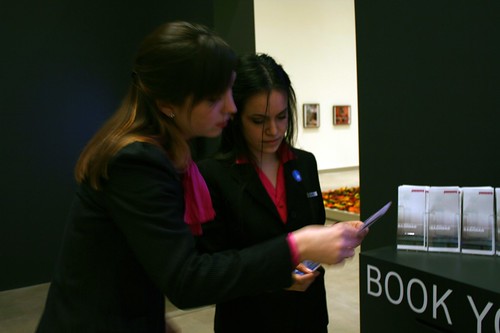


Bitch Magazine
Acciones Plásticas was discussed in current issue of Bitch Magazine Lost and Found #38. The article is entitled The Princess Diaries: In an Age of Ostentation the J.A.P. is Back written by Julia Appel, a rabbinical student at Hebrew College.To view the full article (pdf version) click here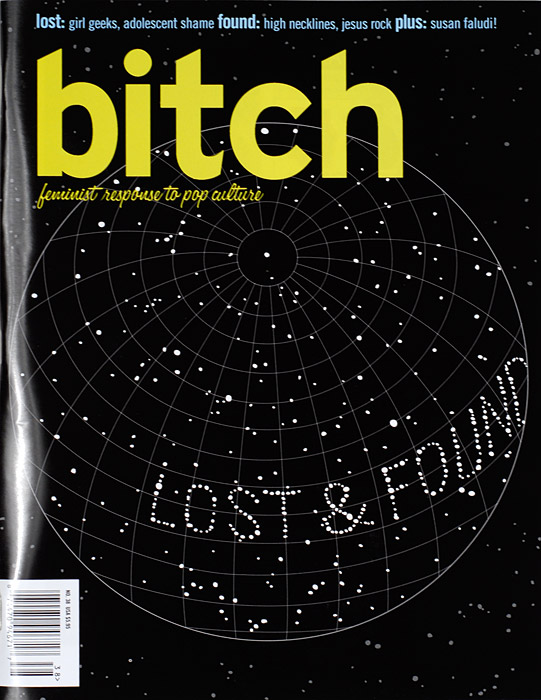
One blogger on Jewschool questioned the artistic success of a new piece by a performance artist named Maya Escobar entitled Acciones Plasticas (Plastic Dolls), in which the artist impersonates in short video segments various stereotypes that make up her identity. Her send-up of the J.A.P. was familiar to me from my years spent in a heavily Jewish, upper-middle-class suburb of Boston. Escobar's J.A.P. flips her straight dark hair and fiddles with her silver jewelry as she talks insipidly about her high-school popularity and rejection of male suitors. The blogger wrote by way of illustration, "She...nails the J.A.P. with a monologue so infuriatingly vapid and unaware it's as excruciating as the real-life experience."

[...]Using the Jewish American Princess in a deadpan manner can result in a sophisticated social critique that reveals how ridiculous the stereotype itself. The key is absurdity: Take Sarah Silverman, who frequently conjures the J.A.P. in her comedy, with mixed results [...] Maya Escobar's piece also falls in this category: by contextualizing the character in her video as a "doll" she reveals how ridiculous it is to take the character seriously. But what about the less-successful attempts at deploying the term? The reason "J.A. P." is ripe for reclamation is because it stands at the border between resonantly hateful and outdated. Although not as widely used as it once was, it still packs a punch. Therefore, if the context is not skillfully executed, the attempt serves not to interrogate or reclaim, but rather only to perpetuate the myth[...]
Cultural Identity Dialog Exchange
Below are selected excerpts from a grant proposal that I recently submitted to Washington University, for a cultural identity dialog exchange between Guatemalan Youth living within the diaspora and those living in Guatemala. Please contact me if you are interested in collaborating, participating (either yourself or your child) and funders.
Within most North American contexts I am inevitably the only Guatemalan representative. As a child I yearned for this paternal classification. I wanted desperately to be a Guatemalan. However, upon entering academia I immediately became the Guatemalan. As an artist, this categorization places me in the awkward position of being unable to produce work without feeling and seeming inauthentic, voyeuristic, and exploitative.In order to directly confront these insecurities and consequential perceptions, I will expose myself to the very environment where I feel most uncomfortable: Guatemala. I will present myself exactly as I do in the United States with the self-imposed title: Guatemalan Jewish Interdisciplinary Artist and Educator. Working as a researcher, artist, educator, student, performer and public speaker I will interact with all of the communities represented by the aforementioned title.
[...]In this lesson, students will critically analyze the ways in which Guatemalans have been depicted both historically and presently. They will look at national and international examples of these depictions, produced by: historians, anthropologists, sociologists, the media, and artists. Considering the mediums that have been utilized in these depictions (newspapers, magazines, history books, movies, paintings, the internet, etc.), and their availability to the general public, students will evaluate the impact of these depictions on the formation of their personal identity.Students will then discuss their feelings towards Guatemalan youth living in the US, who have inevitably been equally (in not more so) effected by these depictions. They will then analyze the specific elements these depictions falsely portray or leave unsaid, thus identifying the important things they want Guatemalan youth living in the US to know about their culture. [...]• What role does an individual play in defining their identity?• How is identity affected by: surrounding community, geographic location, socio-economic background, religious beliefs, political affiliation, gender, sexuality, level of education, access to technology?• What responsibilities accompany self-imposed cultural allegiance?• What responsibilities accompany societal-imposed cultural allegiance?
student work from Cuyotenango, Guatemala 
Do-it-yourself Coloring Book
Nuevos Compañeros 2
Please Check for updates, as I continue to add more to this post.Dianna Montano Dianna Montano is currently finishing her BFA in sculpture/ installation/ new media art at Colorado State Univeristy in Albuquerque, NM.When I found her Ay Chico (Lengua Afuera) Music Video, on youtube I immediately contacted her and asked her if she would be interested in collaborating. She gladly agreed, so I am introducing her work as continuation to theNuevos Compañeros post.[youtube=http://www.youtube.com/watch?v=IGa3HK_tVBg]Dianna says:
Critiquing the onslaught of perversion, and obsession of Latina women. This video subverts the stereotype, by overtly portraying what is all too prevalent in mainstream culture. Latina women are poised as nothing more than sex objects. With this, the woman literally becomes the "spicy latina" everyone desires. It also relates to how Latina women deal with the stereotypes and expectations that are imposed by sources such as family, religion, and the media. For Latinas, sexual power is in constant conflict.
Below is an installation shot of her piece: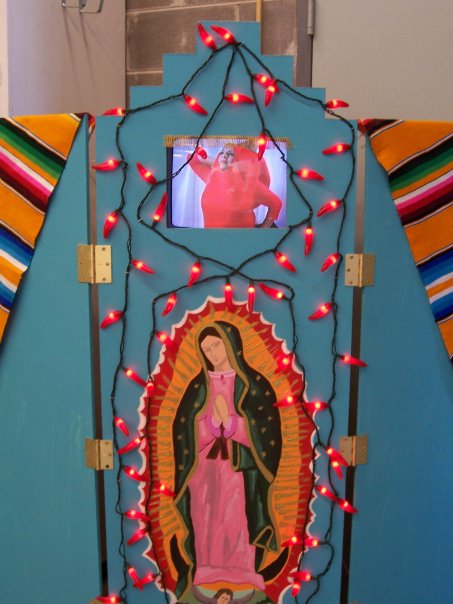 My "Spicy Latina" piece in its full glory. It doesn't get any better than chili pepper lights, Mexican sarape blankets, a traditional Virgin de Guadalupe, and a gold dangly. ay ay ay!!Check out this post Identity Issues Affecting Puerto Rican Girls: An Artist Speaks to hear more on the Spicy Latina.
My "Spicy Latina" piece in its full glory. It doesn't get any better than chili pepper lights, Mexican sarape blankets, a traditional Virgin de Guadalupe, and a gold dangly. ay ay ay!!Check out this post Identity Issues Affecting Puerto Rican Girls: An Artist Speaks to hear more on the Spicy Latina.
I have been told “Oh you just look like you like to have sex” (by both men and women.) I have come to expect this as the norm: being called a spicy latina, hot tamale, firecracker and other such fiery terms. Cofer states that “advertisers have designated “sizzling” and “smoldering” as the adjectives of choice for describing not only the foods but the women of Latin America.”
Maya Escobar isn't even Jewish
UPDATE: PHOTOS
 On an almost daily basis, I receive emails from people asking if I am in fact actually Jewish. Although I do find it somewhat bizarre that they find satisfaction in my acknowledgment of what I have already stated numerous times, I usually respond. Come to think of it, the occasions where I have been accepted as a Jew (without further questioning) have been few and far between.
On an almost daily basis, I receive emails from people asking if I am in fact actually Jewish. Although I do find it somewhat bizarre that they find satisfaction in my acknowledgment of what I have already stated numerous times, I usually respond. Come to think of it, the occasions where I have been accepted as a Jew (without further questioning) have been few and far between.
- “ No you can’t be Jewish you are Hispanic”
- “You don’t look Jewish”
- “Escobar… is that a Sephardic name?”
Recently I discovered that without our knowledge, the validity of my own and my brother Gonzalo’s Jewishness has come into question (to the point where documentation has been requested) from people that we are now very close with.Below are some of the examples of comments (not emails, I do not share the content of emails without permission) from youtube:
roundedwhtcollar Am I the only one who thinks this reprobate Turd is NOT in fact a Jew? Rafaelpicc But is her las name jewish? or converted? ReptorY her last name isnt jewish. xruchy you are not jewish i guess... tus videos= cero aporte raquelita40 she's half Jewish/ half Guatemalan.nakedjanet i am also suspicious. for one thing, escobar is not a typical Jewish name. For another, Jewish girls are usually a whole lot smarter, and have a whole lot more substance, than this girl has
(from chaptzem blogspot) There is no way she is Jewish- there may be a small chance her family are anusim or something.But what gets even more bizarre is that interspersed with in those comments are horrible anti-semitic statements:
johnnycastle86xx all the jews have to die, stupid jewish puta de mierda. Que mierda que Hitler no mato a tu familia, asi tu no hubieras nacido. muerte a los judios y muerte a israel. mocrostyle3600 AnotherJewish nasty bitchmrrimfire She's an ugly cockroachfilet there's a nice Jewishcrew- club... Its re-open and called Auschwitz. the drinks are on the house!!! but only for jewish people roshanpinto13 i want to put you in a concentration camp bitch if your people want israel so bad why don’t you go there and rid the world from your hideous jewish ways
So in light of my sarcasric sense of humor I entitled this post : Maya Escobar isn’t even Jewish I wonder what will come of that statement... From Judaism 101: Who Is a Jew?
First, traditional Judaism maintains that a person is a Jew if his mother is a Jew, regardless of who his father is. The liberal movements, on the other hand, consider a person to be Jewish if either of his parents was Jewish and the child was raised Jewish. Thus, if the child of a Jewish father and a Christian mother is raised Jewish, the child is a Jew according to the Reform movement, but not according to the Orthodox movement. On the other hand, if the child of a Christian father and a Jewish mother is not raised Jewish, the child is a Jew according to the Orthodox movement, but not according to the Reform movement! The matter becomes even more complicated, because the status of that children's children also comes into question.
In my case my mother is Jewish and my father is not. Yet it is my father that pushed me to go to Hebrew school until I was 16. Rain or shine my parents have been attending Shabbat services at JRC for almost 20 years. I remember being so mad as a child that my friends got to go out on Friday nights, and I was stuck with my family not even allowed to watch TV when we got home from services. Vickie Korey left the nicest comment on my Rabbi Brant Rosen’s blog:
I remember Maya at Friday night services at JRC, sometimes listening intently, sometimes reading, but always being present. When one of the children of our extended spiritual family grows to be such a fine, thoughtful and accomplished young woman we are all proud. Gonzolo and Tina have worked hard to set a strong foundation for Maya and I am so pleased for her and her family.
A few months ago I met with my Rabbi to discuss my (art) work. During our discussion I mentioned to him how my father is feeling really nervous about me having an orthodox wedding where he will not be included in the ceremony. Brant said something to me that really touched my heart. Your father is the essence of what a Jew is, he is a stranger in a strange land. I agree with him whole-heartedly, and if you ask most JRC members I am sure they would agree as well. However that does not change the fact that he is not considered to be Jewish by our neighbors, and even if he converted, to them it would not be halakhic unless he went through orthodox conversion. So who is a Jew? Who determines this?As I stated in a previous post I will be working as the art director this summer for Camp JRF. I am in the process of creating this summer’s curriculum that will be geared towards answering these very questions and challenging notions of Jewish Identity. Below is a very rough sketch of my plan…. (Please let me know if you have any suggestions, or would be interested in contributing any resources) The Changing Face of Jewish Identity: an exploration of self and what it means to be a Jew in our contemporary societyTo introduce the concept of a changing Jewish Identity will discuss the following:
- How do we define ourselves/ how do others define us?
- Who is a Jew?
- Can someone be more or less Jewish/ who decides this?
- What is our role in society?
- What characteristics make up a Jew?
Mediums Mixed media sculpture Art Exhibitions The Jewish Identity Project Too Jewish Challenging Tradition Identities Written Works by Ilan Stavans Achy Obejas Rebecca Walker Campers will produce mixed media sculptures that reflect their perception of what it means to be a JewPre- Activities:
- We will begin as an ice breaker/ intro to project identifying the characteristics that make up Jews.
- Followed by a discussion on contemporary representations of Jews in Popular culture
Project Campers working in groups of 3-4 will have the option of creating either abstract or representational mixed media sculptures that to them represent Jewish identity. Prior to the construction of their piece students will need to create a (flexible) proposal that outlines their piece.
- Will it be site specific (interact with a certain location)?
- What form will it take?
- Will it have a function?
- What materials will be used based on the above?
If they end up going with more representational sculptures I thought it would be really cool to photograph the sculptures and to place them in various Jewish settings and non-Jewish settings (baseball stadium, temple, Shabbat dinner, work, school....)
Identity Issues Affecting Puerto Rican Girls: An Artist Speaks
In her essay The Myth of the Latina Woman/ Just Met a Girl Named Maria, Judith Ortiz Cofer describes her Puerto Rican upbringing in a strict Catholic home in New Jersey, where she was taught to behave like a proper señorita. Cofer explains that the conflicting messages she received as a child, were those commonly propagated by Puerto Rican mothers. “They encourage their daughters to look and act like women and to dress in clothes that our Anglo friends and their mothers found to mature for our age.”When the mere notion of latinidad equates passion and sexuality to gringos, why is it that Latino men are the first ones to point finger and to call these same women suelta (loose) or facil (easy)? Wouldn’t they understand? Have they not been subjected to the same treatment? Perhaps it is comes down to the way they were raised.In the Latino culture ideas of masculinity and femininity are delineated very early on. Author Evelyn P. Stevens, first introduced this concept know as machismo and marianismo in 1973. Machismo grants supreme authority of the man over the woman. Under this doctrine women, who are considered to be morally and spiritually superior to men are able to endure abuse. They grow up expected to follow the sexual code of marianismo, and are submissive to the man’s authority.Puerto Rican culture places women into one of two categories the virgin or the whore; mujeres de la casa (women of the home) or mujeres de la calle (women of the street). Una mujer de la casa, is expected to be pure, giving and compassionate. While, una mujer de la calle is considered to be sluty, wild, and dangerous.In Honor and the American Dream: Culture and Identity in a Chicano Community, author Ruth Horowitz says the following:The very presence of a woman outside the household implicates them in promiscuity and/or sexual misconduct. Puerto Rican girls learn this good girl/bad girl dichotomy most clearly in the recruitment into reproductive labor… A good girl cooks, cleans, takes care of younger siblings, and helps her parents. In contrast una muchacha de la calle is a transgressive women who has gone beyond patriarchal control whose sexuality is unbounded and therefore dangerous.While in Puerto Rico this January, I had the privilege of meeting the incredibly talented video artist, Tamara Liz Rivera Boria. Tamara and I instantly bonded, finding similarity in the content of our work, and decided that we needed to collaborate.I conducted a short series of interviews with her (documented with the camera from my laptop), where she describes her work as it plays on the screen behind her…[youtube=http://www.youtube.com/watch?v=I2SdDl2zaus] click on above image to view videoInterview with Puerto Rican Artist Tamara Liz Rivera BoriaMaya: Tamara, what can you tell me about muchachas de la calle and muchachas de las casa?Tamara: De la casa and de la calle girls might as well be related. They exchange roles sometimes, de la casa girl wanting to be de la calle, and vice versa.Maya: How has this affected you?Tamara: I was raised in a catholic home, in a catholic school. I can tell you, I have been fucked up. I didn’t want to be told what to do, or what to believe in.How can you tell someone that using a condom is a sin? I had many issues over the years being raised like that. Even though my parents are not Catholic extremists. They were pretty easy going that’s how they could understand me or deal with me. Deep inside it made a mark, no matter how much I tried to live and understand the world. I became insane trying to understand other people lifestyle because indeed I might have been raised inside a bubble. I still am kind of in there, don’t wanting to look at how things really are.Maya: What role does your cultural upbringing play in your work?Tamara: Recently I made a video called él, baño de marîa. In this video I present various symbolism about religion, pecados (sins), sexuality, purity, faith among other things. Mainly because our culture has raised us thinking inside the box, controlling us with Christianity, especially Catholicism. Being pure, waiting till marriage although most don’t do it, is deep inside the mind. Like it is wrong to embrace sexuality.Aglubium, is another video I made in collaboration with Ralph Vazquez and Rebecca Adorno. In this video I am drowning, or trying to kill myself by submerging my head in the water. It’s aggressive, and it’s beautiful. We just want to end, we don’t want to think. We don’t want to face fears. We don’t want to wait, we want to get it over. We want to drown our fears. We don’t want to face reality. Escape its what we do.Maya: How do you escape?Tamara: Most people (Puerto Ricans) use drugs. Puerto Ricans that do not use illegal drugs, use legal pills, alcohol or even coffee. Everyone has an addiction. It’s a shame but I have seen most of my friends doing drugs. I been there, I done that but I never had an addiction. My new boyfriend said I was an alcoholic, he didn’t believe me when I said I wasn’t. It wasn’t till he lived with me for over a moth when he saw that I didn’t drink for so long that he believed me, and with the cigarettes the same.For some weird reason I can try things for as long as I want and not create any addiction. I wish it were the same with those that surround me. But in the arts almost all the people I know use some kind of drugs, are the ones that worry me the most are the most intelligent that keep using. I guess they are not that smart…Maya: Is there an alternative to escape?Tamara: I can see clearly that with true art I can make a difference, I can say what I understand to be real and important. I might help somebody. Other people just ignore what is going on (Puerto Rico). So many things had happen here, that demanded the people marching up the streets in protest, because our government is insane. But people don’t, they just “sit quietly”. They don’t want to get involved, they think they cannot change anything. They believe they have no power, when indeed I say, with all your power, what would you do? – I love that flaming lips song-Maya: How does this affect Puerto Rican girls?Tamara: Puerto Rican girls have many issues. Not only because of gringos (Americans) our identity issues extend into religion and the ways women are portrayed in the reggaeton culture. Girls want to be thin like gringas (American girls), they don’t like they’re beautiful curves, ass and tits. They always feel fat no matter how thin they are. I bet this happen everywhere, but these are issues we shouldn’t have.Accepting ourselves, as we are its what we should do. Because we are not gringas! We are not blonde and white! But boys see these girls in TV, and everywhere and they expect girls like that. It’s the gringo media. I’ve forgotten all about this, but I also had these issues. I think I kind of still do, I just ignore most of the time.Maya: You mentioned Reggaeton, what message do you think Reggaeton is sending to young women?Tamara: Reggaeton is a part of that movement leads ladies to feeling less than the man, like he has to buy her. Girls learn to use their sexual power way to early with reggaeton. It is a confrontation for some, between what they like (reggaeton movement, lifestyle) and the religious foundation they might have. But since it probably was forced (religion) they escaped thru reggaeton. Ultimately ending in ugly situations.Maya: Okay , I agree with you. But I am not going to lie, I love reggaeton… are you sure you don’t secretly like it?Tamara: I don’t dig reggaeton; I see how girls embrace being just a piece of meat, especially high schools girls. How much is this necklace, like a million? Said a girl, the boy answered – no. The girl said - well then, work and buy me this necklace.Yesterday I heard a senior girl say that to her boyfriend at a hotel, it was their prom. Girls parade in lil’ dresses, easily they could have been mistaken for high-class whores. I won’t even comment on the dancing. It has gotten worse, every time. Since parents are so young they allow they’re children to behave like this. I mean, I see a problem with these situations. Boys catch another boy,looking at their girls, no matter if its sexual or if they just passed and look because its simply there, they get all worked up and want to fight. What is that dumbass looking at? So basically, what, people cant look at each other now? Girls can’t stand if you look at them either. Puerto Rico was not like that; you went to the mall, smiled and people smiled back at you.The reggaeton anger and sexual damage can be easily identified. Even kindergarten boys are sexually harassing little girls. My mom is a teacher and I have heard some stories. I haven’t analyzed reggaeton issues deeply; this is just for what I have seen.Maya: Thank you for your insight Tamara, I can’t wait to see what you produce next. I hope we can collaborate together in the future.Tamara: I know I could make more sense out of my ideas, since they’re not organized very well, but it doesn’t matter. This is just the beginning of many wonderful works to come, ideas to flow… I’m glad that I can collaborate with you.
click on above image to view videoInterview with Puerto Rican Artist Tamara Liz Rivera BoriaMaya: Tamara, what can you tell me about muchachas de la calle and muchachas de las casa?Tamara: De la casa and de la calle girls might as well be related. They exchange roles sometimes, de la casa girl wanting to be de la calle, and vice versa.Maya: How has this affected you?Tamara: I was raised in a catholic home, in a catholic school. I can tell you, I have been fucked up. I didn’t want to be told what to do, or what to believe in.How can you tell someone that using a condom is a sin? I had many issues over the years being raised like that. Even though my parents are not Catholic extremists. They were pretty easy going that’s how they could understand me or deal with me. Deep inside it made a mark, no matter how much I tried to live and understand the world. I became insane trying to understand other people lifestyle because indeed I might have been raised inside a bubble. I still am kind of in there, don’t wanting to look at how things really are.Maya: What role does your cultural upbringing play in your work?Tamara: Recently I made a video called él, baño de marîa. In this video I present various symbolism about religion, pecados (sins), sexuality, purity, faith among other things. Mainly because our culture has raised us thinking inside the box, controlling us with Christianity, especially Catholicism. Being pure, waiting till marriage although most don’t do it, is deep inside the mind. Like it is wrong to embrace sexuality.Aglubium, is another video I made in collaboration with Ralph Vazquez and Rebecca Adorno. In this video I am drowning, or trying to kill myself by submerging my head in the water. It’s aggressive, and it’s beautiful. We just want to end, we don’t want to think. We don’t want to face fears. We don’t want to wait, we want to get it over. We want to drown our fears. We don’t want to face reality. Escape its what we do.Maya: How do you escape?Tamara: Most people (Puerto Ricans) use drugs. Puerto Ricans that do not use illegal drugs, use legal pills, alcohol or even coffee. Everyone has an addiction. It’s a shame but I have seen most of my friends doing drugs. I been there, I done that but I never had an addiction. My new boyfriend said I was an alcoholic, he didn’t believe me when I said I wasn’t. It wasn’t till he lived with me for over a moth when he saw that I didn’t drink for so long that he believed me, and with the cigarettes the same.For some weird reason I can try things for as long as I want and not create any addiction. I wish it were the same with those that surround me. But in the arts almost all the people I know use some kind of drugs, are the ones that worry me the most are the most intelligent that keep using. I guess they are not that smart…Maya: Is there an alternative to escape?Tamara: I can see clearly that with true art I can make a difference, I can say what I understand to be real and important. I might help somebody. Other people just ignore what is going on (Puerto Rico). So many things had happen here, that demanded the people marching up the streets in protest, because our government is insane. But people don’t, they just “sit quietly”. They don’t want to get involved, they think they cannot change anything. They believe they have no power, when indeed I say, with all your power, what would you do? – I love that flaming lips song-Maya: How does this affect Puerto Rican girls?Tamara: Puerto Rican girls have many issues. Not only because of gringos (Americans) our identity issues extend into religion and the ways women are portrayed in the reggaeton culture. Girls want to be thin like gringas (American girls), they don’t like they’re beautiful curves, ass and tits. They always feel fat no matter how thin they are. I bet this happen everywhere, but these are issues we shouldn’t have.Accepting ourselves, as we are its what we should do. Because we are not gringas! We are not blonde and white! But boys see these girls in TV, and everywhere and they expect girls like that. It’s the gringo media. I’ve forgotten all about this, but I also had these issues. I think I kind of still do, I just ignore most of the time.Maya: You mentioned Reggaeton, what message do you think Reggaeton is sending to young women?Tamara: Reggaeton is a part of that movement leads ladies to feeling less than the man, like he has to buy her. Girls learn to use their sexual power way to early with reggaeton. It is a confrontation for some, between what they like (reggaeton movement, lifestyle) and the religious foundation they might have. But since it probably was forced (religion) they escaped thru reggaeton. Ultimately ending in ugly situations.Maya: Okay , I agree with you. But I am not going to lie, I love reggaeton… are you sure you don’t secretly like it?Tamara: I don’t dig reggaeton; I see how girls embrace being just a piece of meat, especially high schools girls. How much is this necklace, like a million? Said a girl, the boy answered – no. The girl said - well then, work and buy me this necklace.Yesterday I heard a senior girl say that to her boyfriend at a hotel, it was their prom. Girls parade in lil’ dresses, easily they could have been mistaken for high-class whores. I won’t even comment on the dancing. It has gotten worse, every time. Since parents are so young they allow they’re children to behave like this. I mean, I see a problem with these situations. Boys catch another boy,looking at their girls, no matter if its sexual or if they just passed and look because its simply there, they get all worked up and want to fight. What is that dumbass looking at? So basically, what, people cant look at each other now? Girls can’t stand if you look at them either. Puerto Rico was not like that; you went to the mall, smiled and people smiled back at you.The reggaeton anger and sexual damage can be easily identified. Even kindergarten boys are sexually harassing little girls. My mom is a teacher and I have heard some stories. I haven’t analyzed reggaeton issues deeply; this is just for what I have seen.Maya: Thank you for your insight Tamara, I can’t wait to see what you produce next. I hope we can collaborate together in the future.Tamara: I know I could make more sense out of my ideas, since they’re not organized very well, but it doesn’t matter. This is just the beginning of many wonderful works to come, ideas to flow… I’m glad that I can collaborate with you.
“Everything that surrounds me, mi entorno, makes a part of who I am and what I say in my videos. Little by little its somehow implicated.”
As I begrudgingly stated in my interview with Tamara, I am a fan of reggaeton. Like most, I don’t even acknowledge the lyrics or really think too much beyond the beat of the music. Yet now I find myself wondering, are most girls conscious of the message? I guess to some extent they must be, after all as Tamara shared many sing the lyrics as they grind (rub up) on men.In my research I found extensive commentary regarding the direction of Salsa and its implications on women in the Puerto Rican community. However, as it is relatively new form of music, the writing concerning Reggaeton seems to be incredibly limited.So I turned to a more contemporary source and found a blog entitled REGGAETONICA, written by Raquel Z. Rivera; author of New York Ricans from the Hip Hop Zone. In a recent post: From White to Mulata: The Darkening Powers of Reggaetón, she shares an email addressing this very issue:
I think reggaeton has been raunchy & explicitly all along, but I think the lyrics have reverted back to the "Reggeaton Sex" days of Underground. I think that "raunchiness" & degradation have become more mainstream & therefore are seen as less scandalous & more acceptable to society, so I think it has questioned our value as a community. The fact that Reggaeton outright refers to sexual references & acts & is accepted as mainstream Puerto Rican culture posing an interesting cultural issue for me. Now you can go to Puerto Rico and see young girls singing "dame con el palo, " & they're parents paying no mind to it, which I think is crazy. In the beginning of Reggaeton I found the lyrics to be much more raunchy, violent, & drug-related. Then mainstream Reggaeton came along, switched the "sexo" to "amor" & the "nenas" to "gatas." I think these subtle changes in language allowed Reggaeton to be more successful in the mainstream, but now a lot of artists are moving back to the original lyrics because they already have a stable fan base. I mean, look at someone like Tony Dize, if you translated some of his songs into English, they could put even 50 Cent to shame with the blatant sexual references & degradation of women.
Perhaps reggaeton is so widely accepted by mainstream and popular culture, because it provides a free ticket to promote these concepts in a non-threatening form. If Puerto Rican women and other Latinas are fine dancing to this music, then what harm is there in gringos doing the same.This then becomes representative of Puerto Rican culture. When a gringa dances to reggaeton she can purse her lips and grind on men, but without an attached stigma. She is just acting like a Latina girl. The Puerto Rican girls participating in this scene are aiding in the further perpetuation of the stereotype of Latina’s being easy.However, as Tamara explained a lot of this has to do with a search for independence. Wanting to rebel against the forced restrictions of being una mucha de la casa, girls go to the furthest extreme to break down those barriers. But to what cost?I myself am unable to provide a concrete solution. Yet I do think that one of the primary steps to forward progress is conversation. Tamara and myself have opted to publish the text on the web so that others may join in the dialog…[youtube=http://www.youtube.com/watch?v=rxiWzxItuzo]
Obsessed With Frida Kahlo
obsessed with frida kahlo, 2007
[youtube=http://www.youtube.com/watch?v=rxqo7aJtD0U]
el es frida kahlo, 2007
[youtube=http://www.youtube.com/watch?v=xlMPoFXRT18]
part of the piece I did for d[x]i magazine on the commodification of Frida Kahlo
auto retrato, 2003
frida painting, 2007
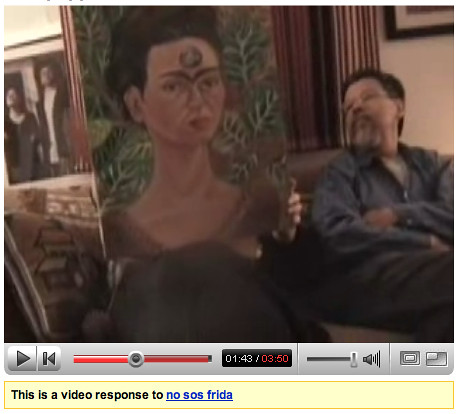
frida puppets, 2007
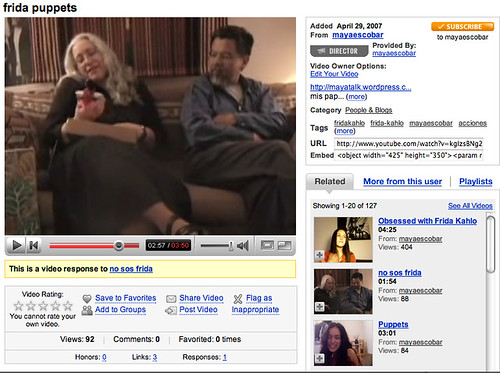
[youtube=http://www.youtube.com/watch?v=QzqBX0HoPSo]
In search of the #1 Frida Kahlo fan in the World

PROVE IT answer the following questions:
When did you fall in love with Frida?
Why do you admire her?
What trivia do you know about Frida Kahlo?
How many and what Frida objects do you own? (prints of her work, t-shirts, mugs, wall hangings, toothbrushes, etc...)





please leave a written comment, submit photos, or a video responseDressed as Frida
your responses
RELATED POSTSGallery OpeningNext Phase of Acciones PlasticasVideo ResponsesHow does it feel to be called a JAP? Now I am asking you to participate. Hopefully viewing these images has caused you to question if and when similar stereotypes have been applied to you or those around you. Please take the time to share your experiences by clicking on any of the dolls to submit your response.



 I have included a section with guiding questions. If you have more you would like to submit post them herePlease feel free but not limited to answering the following questions regarding each doll:
I have included a section with guiding questions. If you have more you would like to submit post them herePlease feel free but not limited to answering the following questions regarding each doll:
Is there any truth to this description?Are all of these things negative?What is the origin of this stereotype?What is a _________ really like?What does this stereotype leave unsaid?
[youtube=http://www.youtube.com/watch?v=wBkROAn7efM][youtube=http://www.youtube.com/watch?v=-kohK1qimhI][youtube=http://www.youtube.com/watch?v=4Zsr4NmtG0I]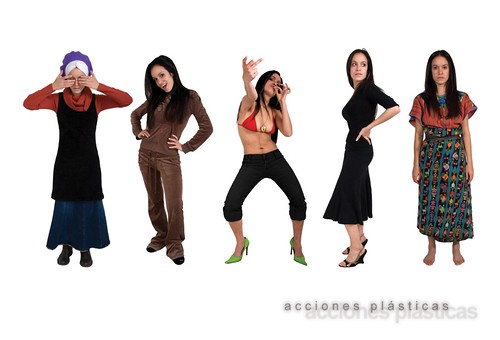
Producto? Inc
UPDATEBraulio was featured on artnet.com Artist Alfi Rolón performing as part of Braulio Espinosa Castillo’s "Artistas de Hoy"
Artist Alfi Rolón performing as part of Braulio Espinosa Castillo’s "Artistas de Hoy"
Circa ’07 also featured a row of smaller booths housing individual projects by invited artists. One of the most popular was "Artistas de Hoy," a project stage-managed by Braulio Espinosa Castillo of Producto? Inc., for which he somehow convinced 40 artists to pose in a glass display case alongside a video of their artwork. The combination was a perfect gambit. Not only were the videos illuminating, but fair visitors clearly were enchanted by the opportunity to stare at real artists standing in a booth.
Producto? Inc. es una propuesta que nace de la reflexión en torno a la condición "natural" del individuo como producto mercantil. Con la dirección de Braulio Espinosa Castillo y la colaboración incondicional de familiares, amigos, colegas artistas y auspiciadores.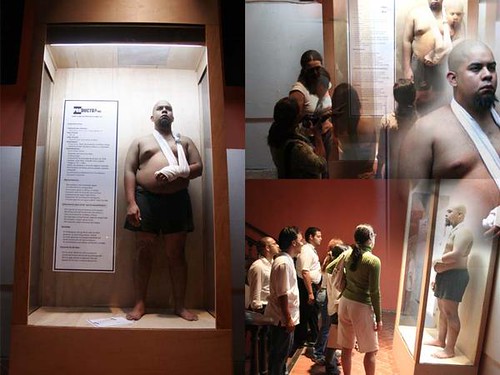
El proceso de cosificación que produce la sociedad de consumo a la que nos enfrentamos a diario no se limita solo a la materia no viviente y no pensante, sino también a los seres humanos: mercaderes y consumidores. Siempre el hombre ha puesto algún tipo de valor sobre la materia, sea viva o no. Un producto mercantil es una cosa producida con la finalidad de la venta. En el contexto actual de vida somos un producto mercantil, primero por que somos una cosa producida. Producida por el hogar, la iglesia, las escuelas, la universidad, los trabajos. Segundo, mientras no exista otro sistema económico, todos cambiaremos dinero por nuestro servicio; trabajo y conocimiento. El salario mide el precio del trabajo, que a fin de cuenta, define el valor material del trabajador, el producto. En algunos países el acto es aún más literal, cuando se venden esclavos, niños y órganos humanos.
En CIRCA 07 estarán participando 40 colegas artistas, cada uno con su propuesta individual de ellos mismos como producto mercantil. Durante 25 minutos estarán en exhibición, en instalación-performace.
Shomer Negiah Panties
SHOMER NEGIAH PANTIES NOW AVAILABLE ON ShomerNegiahPanties.comShomer Negiah is a concept in Jewish law halacha that prohibits any degree of physical contact with, or touching of, a member of the opposite sex, except for one's spouse and immediate family. Shomer means “guards”, but due to its common use in phrases relating to religious practice, it has come to mean: “adhere to” as well. Negiah is the Hebrew word for “touch”, and thus Shomer Negiah is a term used to describe one who “guards the touch” or simply “adheres to restrictions of touch”. Although the feminine form of the term is technically Shomeret Negiah, it is almost always used in the masculine, even when in reference to women. Shomer Negiah Panties allow a woman to abide by the halacha, but still be individual and sexy at the same time. post by dovbear on the panties recieved these comments
post by dovbear on the panties recieved these comments
my pink sexy low cut bras say vlo sasuru in micro print ... lolfrumbabe | Homepage | 02.22.07 - 2:00 pm
why don't you ASK her, DB? Or would that be un-tznius (as opposed to, say, visiting her blog, looking at her panties, and then tattling on your own blog...) :)Tzipporah | Homepage | 02.22.07 - 2:34 pm
this is much more tzanuah.Trust me. I'm a man :)DovBear | 02.22.07 - 2:44 pm
"Shomer Negiah Panties," essentially ordinary cotton undies, I'm going to run over to CafePress and put some "Shomer Negiah Thongs" up for sale.Al Gore | 02.22.07 - 3:07 pm |
What about the fringes? Women unite for equality! We want fringes on our panties!Anonymous | 02.22.07 - 3:13 pm
How about upgrading to a tattoo strategically placed on one's behind? This could be a real trend on the upper west side!Anna Nicole | 02.22.07 - 3:18 pm |
How about upgrading to a tattoo strategically placed on one's behind? This could be a real trend on the upper west side!
Totally unecc. In Willy. they've found the combination of bald heads and really thick stockings serve the same purpose.DovBear | 02.22.07 - 3:27 pm |
that's a weird fetish. :)Tzipporah | Homepage | 02.22.07 - 3:31 pm |
Not a fetish. A form of birth control.Anon | 02.22.07 - 3:39 pm |
I think it's just for giggles. I could imagine SN girls giving each other these panties as a joke... the number of SN guys who'll ever see them on a girl is probably tiny.quietann | 02.22.07 - 4:10 pm |
Granny panties are by definition shomer negiah.--------
Perhaps what the world REALLY needs are burqas with playboy bunnies or 'party-babe' stencilled across the front.The Back of the Hill | Homepage | 02.22.07 - 4:18 pm |
DB:Been done before. Look, don't you think this makes the statement just a bit more...... pointed? http://www.corkscrew-balloon.com...torture/ 31.html
Anon:"A form of birth control"
A form of birth control??? Wow, I'd hate to know what you consider birth-out-of-control, then.Baal Devarim | Homepage | 02.22.07 - 4:33 pm |
that's hot....ThePervert | Homepage | 02.22.07 - 4:52 pm |
I just don't see it.Then why bother giving old Maya and her incredibly unfunny, juvenile and tasteless underwear any more free publicity? What motivates you to post what you do really mystifies.Chaim G. | 02.22.07 - 5:13 pm |
Oooh, these could be useful for the frum girl who secretly moonlights as a stripper. Warning, guys -- all lookie, no touchie.GoldaLeah | 02.22.07 - 5:19 pm |
the frum girl who secretly moonlights as a stripper. A match truly made in hell as her audience would no doubt comprise frum boys who secretly "moonlight" as patrons of "gentlemens" clubsChaim G. | 02.22.07 - 5:28 pm |
Kinda like the "Sanitized for your protection" ribbons on motel toilets.Psycho Toddler | Homepage | 02.22.07 - 5:54 pm |
A match truly made in hell as her audience would no doubt comprise frum boys who secretly "moonlight" as patrons of "gentlemens" clubs...I now have this mental image of bearded young gentlemen wearing ill-fitting 'gentile' clothes yelling "remove your sheitel, remove your sheitel". Thank you. It will take me a while to get over this trauma.The Back of the Hill | Homepage | 02.22.07 - 6:14 pm |
BOTHDain ershtoinung iz gornit antkegen der ershtoinung fun zaira vaiber If only such occurences were as humurous and harmless as the "sleeveless bar" scene that you conjured.Chaim G. | 02.22.07 - 6:20 pm |
I can see them being a present for a friend too--or a joke for one's husband.I don't see them having any halachic purpose, though. Unless there's a mitzvah to wear tacky panties that I somehow missed.balabusta in blue jeans | Homepage | 02.22.07 - 6:27 pm |
I'm married, and I would wear them. I think they're hilarious. But I'd be too scared to give them to anyone I know--they might take it the wrong way.Rivka | 02.22.07 - 8:39 pm |
Pardon me for the overshare, but I have a pair of panties that say "Girls know best" on the front. And there are times that they are appropriate for the situation, like maybe when I need a reminder that girls really do know best :) (I am almost 43, so hardly a girl, but the sentiment is the same.)Similarly, I could see a shomer negiah young woman wearing these panties on a date. Just knowing what her panties say might help her keep her skirt on!quietann | 02.22.07 - 10:21 pm |
at the mall any day now, i'm expecting to see "Shomer Negiah" stenciled on the butt of some babes yoga pants...eliyahu | Homepage | 02.22.07 - 11:15 pm |
I am truly mystified that this post existsreality | 02.23.07 - 7:38 am |
It's obviously a gag. What's the big deal? Girls that are really shomer are never going to wear them with any expectation that a guy will see them, and those that aren't will wear them for their ironic humor.nicejewishguy | Homepage | 02.23.07 - 11:15 am |
How about upgrading to a tattoo strategically placed on one's behind?Also know as a "Tramp Stamp."Al Gore | 02.23.07 - 12:26 pm |
It should also say "shomer negiah" in braille in case it's dark in the room when being read.Should also say it in Hebrew or Yiddish, so the message is clear to all chareidim as well.B.T.A. | Homepage | 02.25.07 - 1:54 pm |
Ah, should have looked at her site first. DB, now you're linking to tushies?! What a shonda. I go away for a few weeks...In any event, perhaps she could tatoo it on the small of her back, then could wear any panties she likes? Just a thought.B.T.A. | Homepage | 02.25.07 - 1:55 pm |



